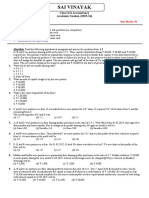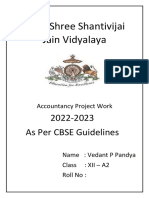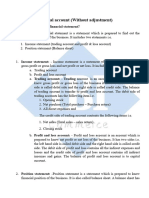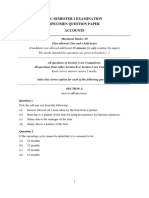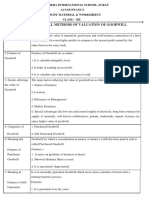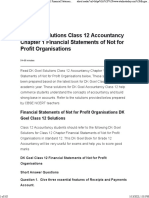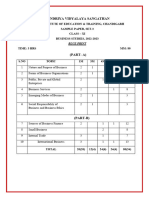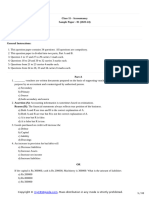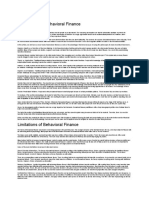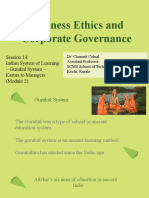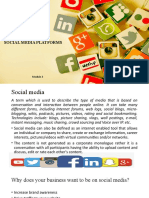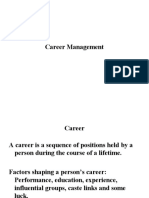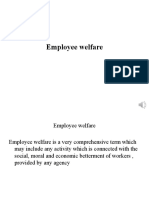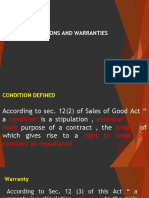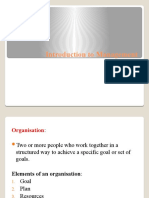0 ratings0% found this document useful (0 votes)
2K views50 pagesFinal Accounts
Uploaded by
Kartika Bhuvaneswaran NairCopyright
© © All Rights Reserved
We take content rights seriously. If you suspect this is your content, claim it here.
Available Formats
Download as PDF or read online on Scribd
0 ratings0% found this document useful (0 votes)
2K views50 pagesFinal Accounts
Uploaded by
Kartika Bhuvaneswaran NairCopyright
© © All Rights Reserved
We take content rights seriously. If you suspect this is your content, claim it here.
Available Formats
Download as PDF or read online on Scribd
You are on page 1/ 50
Final Accounts
(Financial Statements)
(kes
After you have studied this chapter, you should be able to:
Understand the meaning and objective of financial statements
Understand the items appearing in Trading Account and that in the Profit and Loss Account
Leam the concept of gross profit and net profit
Understand how to make closing entries.
Know the meaning and preparation of manufacturing account.
Ciassity items into assets and liabilities
Leam the relationship between Profit and Loss Account and Balance Sheet.
Pass necessary adjustment entries
Prepare Trading Account, Profit and Loss Account and also Balance Sheet from Trial Balance and
‘additional information given.
2 Know the difference in the final accounts of sole traders, partnership firms and joint stock companies.
introduction
It was explained in Chapter 3 (Accounting Process) that transactions of a business enterprise
‘ue first recorded in the journal, posted therefrom into the ledger and then a trial balance is
prepared. The next step after preparation of the trial balance is to prepare final accounts. These
final accounts consist of the following basic financial statements:
1. Trading and Profit and Loss Account — to ascertain the profit or loss of the business _ Preparation of
uring the financial year, and final accounts la
2, Balance sheet — to show the financial position of the business at the end of the ‘™ayanal ane of
financial year. sccounting
Trading and Profit and Loss Account is split into (a) Trading Account (to show the gross
Profit), and (b) Profit and Loss Account (to show the net profit). This is explained below.
74
RE
a
12 Accounting" Mansy,
apne te Se But before ascert
‘At the end of the year, the net profit/loss is to be a ‘ trading account. Thus, at
. Profit, frst of all gross profit is ascertained by PIEPAUEN © ON oss. Gross profi at
account is prepared to know the amount of gross PI ty
difference between sales and cost of goods sold.
Thus, Grose Profit = Sales ~ Cost of goods sold
‘Or Gross Profit + Cost of goods sold = Sales _ d data) :
. The cost of goods sold is computed as follows (with assumed CRIN) +
Hi
OO _!
Opening stock i Sy
Add : Purchases (Less purchases returns) oe fa
‘Add: Dinect expenses : cea
Cost of goods available forsale
Less : Closing stock
~ hi
: 7 eo
Cost of Goods Sold a
The term direct expenses includes all those expenses which the incurred in bringing ts
goods toa saleable state, These direct expenses are cartage, freight, wages, etc.
The above calculation may also be made by preparing Trading Account, which appeas x
follows:
Dr. ‘Trading Account for the year ending...... 6
Particulars | Particulars q
To Opening stock — | By Sales (less returns) -
‘To Purchases (less returns) — | By Gosing stock -
‘To Direct expenses, — | By Gross Loss (balancing figure) :
‘To Gross Profit (balancing figure)
Total =} Total =
Poort
Illustration 7.1
With the help of following information find out the lasing Stock:
’ {
Gross Profit 5,000 Sales soa
Opening Stock 10,000 Sales Returns a
Purchases 1,00,000 a
Solution:
‘To Opening Stock
‘To Purchases
To Gross Profit,
Final Accounts (Financial Statements)
lustration 7.2
“Ascertain the cost of goods sold :
Opening stock 5,000 Purchase returns 1,000
Closing Stock 6,000 Sales retums 1,800
Purchases 55,000 Wages 4,900
Sales 80,000
Solution:
‘Trading Account
e z
To Opening Stock 5,000 [By Sales "30,000
To Purchases 55,000 les: Sales returns 14800 78,200,
Less: Purchase returns 1,000 54,000 |By Closing stock 6,000
To Wages 4,900
To Gross Profit (Balance Fig.) 20,300
84,200 34,200
Cost of goods sold = Sales ~ Gross Profit
Cost of goods sold = 78,200 - 20,300 = € 57,900
Alternative Method
= Op. stock + Net purchases + Wages - Closing stock = Cost of goods sold
= 5,00 + (55,000 ~ 1,000) + 4,900 6,000 = 57,900
‘Trading Account Items
‘Trading account is a nominal account and its purpose is to ascertain the ‘gross profit or gross
loss.’ The first item on the debit side of trading account is opening stock. The other items on the
debit side are purchases and all direct expenses. On the credit side, the main items are sales and
closing stock. The difference between the two sides is either gross profit or gross loss as shown
above in Trading Account. The main items of trading account are briefly described below :
1, Opening stock : The closing stock of the preceding year is the opening stock of the
‘current year. The opening stock is recorded in the books through an opening entry in the
beginning of the accounting year. This amount remains unchanged during the year and appears
in the trial balance at the end of the year. It should be noted that when a new business is
started, there will be no opening stock in the fist year.
2. Purchases and Purchase Returns : The purchases account in the trial balance represents
total purchases (credit + cash) during the year. Purchases include import duty, octroi, etc. The
purchase returns account has a credit balance showing the return of goods to the supplies. In
the trading account, the net purchases are shown on the debit side i.e., total purchases less
purchases returns.
3, Direct Expenses : In a merchandising business of buying and selling, all expenses
incurred on purchase of goods and to bring them in saleable condition are direct expenses and
‘are charged to Trading Account. However, in the case of a manufacturing business, direct
‘expenses also include the cost of converting raw materials into finished goods. Thus the direct
‘expenses to be debited to trading account include — wages, carriage/freight on purchases,
expenses like power, lighting, gas, fuel, water rent, royalty paid on production, etc.
4, Sales and Sales Returns : The sales account appears in the credit side of a trial balance
showing the gross total sales (cash + credit). The sales return has a debit balance and shows the
Amount of goods returned by the customers. In the trading account, net sales (i.e. total sales
‘Minus sales retums) are shown on the credit side.
73
Accounting for Managemen,
5. Closing stock : Closing stock means stock of unsold goods at the end of the accounting
period. Normally, closing stock account does not appear in trial balance and it is given as =.
adjustment outside the trial balance. This is because such an account is not maintained in th,
‘books. In order to ascertain the vale of closing stock, physical stock taking is done and stock js
valued. Closing stock is then shown in the trading account on the credit side.
fa
ees
: jon
After considering the various items discussed above, the Trading Account will appear a. ~ posch?
follows: , Rett
‘Mustrative Trading Account si
i for the year ending...
Partials | © | Particwars
‘To Opening stock By Sales.
Add: Purchase
Less: Sales returns
Less: Purchases returns By closing stock
‘To Direct expenses By Gross loss c/d (Bal. Fig)*
To Camtiage or freight inwards
‘To Wages
‘To Wage and salaries,
To Power
To Factory lighting
‘To Consumable stores,
To Fuel and gas
To Coal and water
To Octroi, import duty and
other taxes on materials
‘To Foremar’s salary
‘To Supervision-factory
‘To Factory manager's salary
‘To Royalty on production
To Other direct expenses
‘To Gross profit c/d (Bal. Fig)*
“Trading account will show either gross profit or gross loss. It is the balancing figure,
Mlustration 7.3
Prepare Trading Account of RK. & Sons for the year ending 3ist March 2014 from the
information given below.
x ’
Opening stock 80,000 Purchases returns 8,000
Purchases 2,10,000 Sales retums 5,000
Carriage inwards 4,000 Closing stock 56,000
Wages 22,000 Power 7,400
Sales 3,04,000 Coal and gas
6,000
Final Accounts (Financial Statements)
Solution:
Trading Account of RK. & Sons
Jor the year ending 313-2014
Particulars e [Particulars r
To Opening stock 20,000 [By Sales 306,000
To Purchases 2,10,000 Less Returns 5,000 2,89,000
ess: Returns 8,000 2,02,000 |By Closing stock 56,000
‘To Cariage inwards 4000
To Wages 22,000
‘To Power 7400
‘To Coal and gas 6000
‘To Gross Profit o/d 33,600
355,000 355,000,
‘Advantages of Trading Account
41, Trading account shows the amount of gross profit or gross loss i.e,, profit & loss from
trading activities.
Gross profit
2. Gross profit ratio (i aa *100] can be computed from data appearing in trading
account. Gross profit ratio indicates the average margin on goods sold and shows whether
selling prices are adequate to give a reasonable profit.
3. Opening and closing stock figures show the investment locked in stocks. It throws light
on the efficiency of inventory management.
PROFIT AND LOSS ACCOUNT
After preparing the Trading Account, the next step is to prepare Profit and Loss Account.
‘The purpose of preparing Profit and Loss Account is to calculate the net profit or net loss of the
business for a given accounting period. It was stated above that gross profit or loss as per
trading account is transferred to Profit and Loss Account. Thus, profit and loss account starts
with gross profit or gross loss, as the case may be. After this, all other expenses and losses
(which have not appeared in trading account) are shown on the debit side of the Profit and Loss
Account. These expenses may be classified as follows :
1. Office and Administrative Expenses : These include salaries paid to office staff, rent and
rates of office premises, office lighting, printing and stationary, postage, audit fee, legal
expenses, etc.
2, Selling and Distribution Expenses : These comprise of advertising expenses, salesmen’s
salaries and commission, packing expenses, warehousing, freight on sales, export expenses,
‘upkeep of detivery vehicles, bad debts, insurance of finished stock, etc.
3. Financial changes : These include interest paid on bank or other loans and public
Aeposits, etc,
4, Miscellaneous Expenses : Items like loss by theft or fire, donations, depreciation of fixed
assets, etc,
Other Incomes : On the credit side of Profit and Loss Account is shown incomes and gains,
other than sales, These include interest income, dividend income, rent received, discount
received, bad debts recovered, etc.
75
78
Accounting for Management
General form of the Profit and Loss Account is as follows:
Profit and Loss Account
for the year ending.
:
Particulars t[Paricuas in 4
To Gross Loss b/a Ty Gross Profit b/d (Tv. from Trading A/c) — ae
(Gr. from Trading A/c, if there is oss) — | By Interest received 10 429% in
To Salaries = | by discount received focariae
To Salaries and wages = | Br commison received = Goss
To Telephone expenses = | By rat on ste of ase :
To Rent and rates = | By Baa debts recovere 7
To Repairs = | By net toss (Balancing Figure) - i
To Bank charges = fo Rent a
To Audit fees = feravelling
To Cariage outward = B Sony &
To Lighting = pais
To Stationery = erence
To Insurance = a
To Postage or
To Discount allowed = Sa Econt
To Loss on sale of assets 7 tp Discoun
To Salesmen commission = ‘o Net Profit
To Packing expenses =
To Seling expenses = Total
To interest on loan =
To Bad debts =
To Provision for bad debts 2
To Depreciation = At the
a me pan 7 stand close
To Net Profit (Balancing figure) = es close
Total = | totat = a
Mlustration 7.4 to Trading :
From the following Trial Balance, prepare a Trading Account and Profit and Loss Account
Trial Balance as on 31st Dec., 2014 om
bosing ent
Dr. Side e | o Side z Aes
Purchases 16,000 | Sales 30,000 the informz
Wages 6500 | Capital 10.685 is
Discount 1,300 | Mortgage and interest to date 3,050 Period. the
Salaries 2,000 | Sundry creditors 2,100 ee The
Travelling expenses 500
Carriage inward 215
Insurance 150
Commission 325
Rent and rates, 500
Cash in hand 25
Cash at Bank 275
Repairs 300
Sundry expenses 55
Mortgage interest 150
Building 4,000
Machinery 11500
Motor vehicles 500
Opening stock (1-1-2014) 5,750
Sundry debtors 3,250
Total 45,805 Total 25,805
Closing Stock on 31st Dec., 2014 was & 6,075.
edd Ah
Account :
a
08
Final Accounts (Financial Statements)
Solution
Trading and Profit and Loss Account
: {fo the year ending 31 Dec, 2014
Particulars: | Particulars -
To Opening stock 5,780/| By Sales — as 30000
‘To Purchases 16,000 | By Closing stock 6,075
Tp Wage 6500
To Caiage inwards 275
‘To Gross Profit ¢/d 7,550
36,075
to Salaries 2.000 | By Gross Profit b/d 7.560
To Rent and rates 500
To Traveling expenses 500
Te Sundry expenses 55
Te Repair 300
te Insurance 150
1 Commission 5
To Mortgage interest 150
Te Discount 1300
‘To Net Profit tr. to Capital a/c 2,270
Total 7,580 | Total 7380
CLOSING ENTRIES
‘At the end of the accounting year, all nominal accounts relating to expenses and incomes
stand closed because these are transferred to Trading Account or Profit and Loss Account. In
other words, all nominal accounts in the Trial Balance are transferred to Trading Account or
Profit and Loss Account with the help of closing entries. After all these accounts are transferred
to Trading and Profit and Loss Account, the balance of this account will show the net profit or
los.
‘A journal entry made for the purpose of closing an expense or income account is known as a
losing entry. The principal purpose of the year end process of closing income and revenue
accounts is to reduce their balances to zero. Since the incomes and expenses accounts provide
the information for preparing the Trading and Profit and Loss Account of a given accounting
period, it is essential that these accounts have zero balances at the beginning of each new
period. The closing entries have the effect of wiping the slate clean and preparing the ground
for recording of income and expense accounts during the succeeding accounting period.
‘Closing Entries for Trading Account
Each account having a debit balance is credited and Trading Account is debited. For
example :
1. Trading Account oo Dr
To Opening Stock
2. Trading Account
To Purchases
Compound Entries. There are several accounts to be debited and several account to be
‘edited. In such cases, compound entries may be passed as shown below. But it should be
ensured that sum of debits must be equal to sum of credits.
1
Accounting for Mi |
The various closing entries for incomes and expenses accounts are as follows:
1, Entry for closing accounts relating to debit side of the Trading Account:
Trading Account .. Dr.
To Opening Stock Account
To Purchases Account
To Sales Retums Account
To Wages Account
To Carriage Inward Account
To Factory Fuel, Gas, Water Account, etc.
2. Entry for closing all the accounts appearing on the credit side of the trading account
Sales Account vw Dre
Purchase Returns Account v. Dr.
To Trading Account
Entry for closing trading account by transferring gross profit to Profit and Loss Account.
Trading Account
Dr.
To Profit and Loss Account
In case of gross loss, the entry will b
Profit and Loss Account Dr.
To Trading Account
Closing Entries for Profit and Loss Account
4. Entry for closing all expenses appearing on the debit side of the Profit and Loss Account.
Profit and Loss Account .- Dr.
To Salaries
To Rent
To Insurance
To All other expense accounts (except those appear in the trading account)
5. Entry for closing alt income accounts appearing on the credit side of the Profit and Loss
Account,
Discount Income Account.
Dr.
Interest Received Account . Dr.
Any Other Income Account (except sales) . Dr.
To Profit and Loss Account
Entry for transferring the net profit to capital account
Profit and Loss Account +. Dr.
To Capital Account
In case of Net loss, the entry will be
Capital Account
To Profit and Loss Account
Mustrat
75
Make closing entries from the Trial Balance given in Mlustration 7.4.
Final Accounts (Financial Statements)
Solution
Closing Entries
Particulars Dnt Cr.
1. Trading Account ou Dr 28,525
To Opening Stock Account 5,750
‘To Purchases Account. 16,000
‘To Wages Account 6,500
To Cartiage Inward Account 25
(For closing debit balances om the Trading Account)
2,| ‘Sales Account Dr. 30,000
Closing Stock Account Dr. 6,075
To Trading Account 36,075
(For closing credit balances appearing in
‘the Trading Account)
3.| Trading Account Dr. 7,550
To Profit and Loss Account 7,550
(For transferring gross profit to Profit
and Loss Account)
4,[ Profit and Loss Account Dr. 5,280
To Salaries Account | 2,000
To Rent and Rates Account 500
To Travelling Expenses Account 500
To Sundry Expenses Account 55
‘To Repairs Account 300
To Insurance Account 150
‘To Commission Account 325,
To Mortgage Interest Account 150
To Discount Account 1,300
(For closing debit balances of Profit and Loss Account)
5.) Profit and Loss Account w= Dr 2270 zi
To Capital Account 2.270
(For transferring net profit to Capital Account)
MANUFACTURING ACCOUNT
Manufacturing account is generally prepared in those business entities which are engaged in
‘anufacturing business. This account is a part of final accounts and is prepared in addition to
Trading and Profit and Loss Account and balance sheet. The main Purpose of preparing a
ing Account is to determine the cost of manufacturing finished goods. Tt not only
Shows the total cost of manufacturing goods but also the elementwise cost such as cost of
materials consumed, direct labour cost, prime cost, factory overhead, etc. If more than one
Product is being manufactured, an account is prepared for each product,
Objectives
‘The main objectives of preparing a manufacturing account ate:
1. To show the cost of manufacturing the finished goods
% To show the main elements of cost, such as cost of materi
‘and other direct and indirect expenses.
Constituent Elements of Manufacturing cost
cost comprises of the following items.
>
ials consumed, direct labour cost
79
7 Accounting for Manage,
i Final Aces
material cost. It is calculay —
1. Cost of materials consumed : It is the same as direct ed ag eee
Opening stock of raw materials Loss Accou
Add: Purchases of raw materials itlustratio
Less: Closing stock of raw materials ee piasat
= Cost of Materials Consumed iene relating to
It should be noted that cost of procuring materials such as carriage inwards, custom jy stocks
excise duties, etc. are included in the cost of purchases. :
2, Direct labour cost : Also known as direct wages, it comprises of wages paid to wore, Ray
who are engaged on converting raw materials into finished goods. We
3, Direct expenses : These are the costs, other than material and wages, which are incurg,
for specific product or service produced. Examples are hire of a special plant, like crane, for uy Purch
in manufacturing a specific product, royalty payable for units produced, etc. Indire
4, Prime Cost : Ths is the total of all direct costs i.e. eae
direct materials + direct wages + direct expenses. ana
5. Factory overhead: These are indirect manufacturing expenses, other than direc Indire
material, direct labour and direct expenses. Examples of indirect expenses in manufacturing ax
power cost, factory lighting, factory rent, factory supervisors salaries, and other factor
expenses. sundr
6. Gross factory (works) cost: It is the total of prime cost and factory overhead.
7. Net factory (or works) cost : It is calculated as: Depre
Gross factory (or works) cost on
‘Add: Opening stock of work in progress Sales
Less: Closing stock of work in progress Office
= Net factory (or works) cost Salari
Proforma of a Manufacturing Account ‘Solution
In the proforma given below, it should be noted that cost of goods manufactured as pe
Manufacturing Account is transferred to Trading Account.
Particulars
br. ‘Manufacturing Account To Opening
Particulars © | Particutars Oe Ps ;
‘o Direct materials consumed : By Net Factory (or works) cost fsa: card
Opening stock www | transferred to aaa
‘Add: Purchases Trading Account
Less: Closing stock Less: Cosi
To Diect wages raw ma
To Direct expenses
Cost
Prime cost pies
To Factory overhead To Diet
Factory lighting 0 Direct e
Factory power fon
Dep. on plant . To Factory
Supervisor's salary el E tndinect
Other factory exp. a B aoc
Factory cost (Gross) Too Bacto
‘Add: Opening work in progress B esa
ess: Closing work in progress pairs
Net Factory (works) cost an
a
ast Accounts (Financial Statements)
when preparing final accounts, the Manufacturing Account, ‘Trading Account and Profit and
toss Account are combined into one account. This is shown in the following illustration.
76
sustain eee
ee pare Manufacturing, Trading and Profit
seating to the year ending 31-3-2013,
‘Stocks:
and Loss Account from the following information
1-4-2012 31-3-2013
7 g .
Raw material 30,000 31,000
Work in progress 39,000 50,700
Finished goods 42,000 47,000
Purchase of raw materials % 1,10,000
Indirect materials 8,000
Wages - Direct 25,000
~ Indirect 12,000
Direct expenses - royalty on production % 19,000
Indirect expenses ~ Factory power % 7,500
~ Repairs of plant 3,000
~ Plant depreciation 6,000
Sundry expenses ~ factory 2,500
~ Office 1,500
Depreciation of office computers 4,500
Cariage inward 2,000
Cariage outwards 3,500
Sales 3,00,000
Office rent and rates 8,500
Salaries 14,000
Solution :
Manufacturing, Trading and Profit and Loss Account
{for the year ending 31st March 2013.
Paticulars @ | Particulars z
Yo Opening stock of raw By Closing work in progress 50,700
Rates 30,000 By Net cost of goods
Mi: Purchases 4,10,000 manufactured tr. to
4: Caniage inward 2,000 Trading Account 1,82,300
1,42,000
"8 sng stock of
oe Materials 31,000
Tenge consumed 111,000
ny ‘wages 25,000
"Ipenses. (royalty) 19,000
Tor, Palme cost 41,585,000
tg ethead :
] Reinet Materials 8,000
. ‘Wages 12,000
Tee "Y Power 7,500
°F plant. 3,000
ma
712
Accounting for Managemen
= Plant depreciation 6,000
~ Sundry expenses-factory 2,500
Gross Factory Cost 1,94,000
To opening work in progress 39,000
2.33.00
To Cost of goods manufactured 1,682,300 | By Sales 3,00,009
To Op. stock of finished goods 42,000 | By Closing stock of finished
goods 41,0,
To Gross profit c/d 1,22,100
© 3,47,000 3,41,00
To Depreciation of office By Gross profit b/d 1,22,1%
computers 4,500
To Carriage outwards 3,500
‘To Sundry office expenses 1,500
To Office rent and rates 8,500
To Salaries 14,000
To Net profit tr. to capital A/c
1,22,700 1.2,100
BALANCE SHEET
After preparation of Trading and Profit and Loss Account, the next step is to prepare Balance
Sheet. The Balance Sheet is defined as ‘a statement which sets out the assets and liabilities of a
firm as at a certain date.’ The purpose of balance sheet is to show the financial position of the
business at the end of the accounting period. The balance sheet is not an account and the two
sides are not the debit and credit sides.
Trading and Profit and Loss Account is prepared by transferring all nominal accounts to
either Trading Account or Profit and Loss Account. The remaining real and personal accounts are
used for preparing Balance Sheet. Real accounts represent various assets and personal accounts
relate to capital, liabilities and assets.
Characteristics: The following characteristics of balance sheet should be noted for its better
understanding :
1, Balance Sheet is prepared as at a particular date and not for a period. It is prepared as
on the last day of the accounting year.
2. Balance Sheet is always prepared after preparing Trading and Profit and Loss account.
3. Balance sheet is not an account (unlike trading and profit and loss account). It is @
statement portraying financial position of the business at a point of time.
4, Balance Sheet is based on the fundamental accounting equation i.e,
Assets = Capital + Liabilities,
Actually, a Balance Sheet is an elaboration of this equation in which the assets, liabilities
and owners equity are listed and the sum of assets is shown to be equal to the sum of
liabilities and owner's equity. If it is not equal, there is certainly an error somewhere.
a4
Lz
2pare Balane
iabilities oft
sition of tt
Final Accounts (Financial Statements)
BALANCE SHEET AND TRIAL BALANCE — DISTINCTION
The main points of distinction between Trial Bi
Trial Balance
It is a list of all the debit and credit balances
from the ledger accounts,
2, It contains all the personal, real and nominal
accounts.
ince and Balance Sheet are:
Balance Sheet
It isa statement of assets and abilities. It does not
Include all the balances.
It does not contain nominal accounts only personal
and real accounts ate included.
3. Its purpose is to test the arithmetical accuracy | Its purpose is to show the financial position of the
of accounts,
4, Tt is prepared before preparing Trading and
Profit and Loss Account.
business,
It is prepared after preparing Trading and Profit and
Loss Account.
5. It is prepared for internal use ie. managerial | It is prepared for external use ie. for parties like
purpose.
banks, creditors, shareholders, income tax
authorities et.
6. Closing stock generally does not appear in the | Closing stock appears on the assets side of the
tial balance.
balance sheet.
PROFIT AND LOSS ACCOUNT AND BALANCE SHEET — DISTINCTION
The main points of distinction are :
Profit and Loss Account
Balance Sheet
Profit and Loss Account shows the profit eared | Balance sheet shows the financial position as on
or loss incurred during a period, generally one | the date ofits preparation.
year.
2, Profit and Loss Account is prepared for a period,
say one year.
Balance sheet is prepared as on the last date of
financial year.
3. It is prepared with the balances of nominal | It is prepared with the balance of real and personal
accounts.
accounts.
4, Nominal accounts transferred to Profit and Loss | Real and personal accounts appearing in the
‘Account are closed by passing closing entries.
Sequence of Items In the Balance Sheet
balance sheet become the opening balances in the
next accounting year.
(Marshalling)
Items in the Balance Sheet are marshalled in the order of permanence or in the order of
liquidity. In other words, items in the Balance Sheet may be put down in either of the two ways:
(a) In order of permanence, or (b) In order of liquidity
Order of permanence indicates the order of the longevity of their life in use and order of
Uguidity indicates the order of the degree of ease with which they can be converted into cash,
Generally speaking, order of permanence is most commonly used by industrial and
commercial business and order of liquidity is
used by banks and other financial institutions.
Generally, sole traders and partnership concerns also follow the order of liquidity whereas
‘companies follow the order of permanence.
713
>
Accounting for Manageme,
Various assets grouped in the two orders will appear as follows:
(a) Order of Permanence
Assets Liabilities
Fixed assets: Owner's capital
Goodwill
Incomes received in advance
Outstanding expenses
Bank loan
Patents and trade marks
Land and building
Plant and machinery
Bills payable
Other fixed assets Sundry creditors
Investments
Stocks in trade
Pre-payments
Sundry debtors
Bills receivables
Cash at bank
Cash in hand
(b) Order of Liquidity
Assets Liabilities
Cash in hand Sundry creditors
Cash at bank Bills payable
Bills receivables Bank loan
Sundry debtors Outstanding expenses
Pre-payments Incomes received in advance
Stock in trade Owners capital
Investments
Fixed assets like:
Plant & machinery
Land and building
Goodwill
Patents ete.
Note : The list of assets and liabilities given above is not exhaustive,
From the above, it may be concluded that where the order of permanence is chosen, fixed
assets will come first, starting with goodwill, land and building, plant and machinery and so on
following by current assets in order of liquidity ending with cash. In the liquidity order, on the
other hand, the reverse is followed, the most liquid (e.g., cash in hand) being taken first, the
remainders following in descending order of liquidity. Fictitious assets, which are obviously 10!
assets at all but merely debit balances not yet written off, will in either case appear at the
bottom of the list.
Liabilities may also be grouped in the same two ways—order of permanence and order of
Viguidity. Thus, where permanence order is being followed, capital, reserves and undistributed
profits-comprising the owner's interest will come first, followed by long term liabilities (secured
and unsecured loans like debentures, mortgage, etc.) and current liabilities and provisions.
Mlustration 7.7
On the basis of Trial Balance given in Illustration 7.4, prepare a Balance Sheet as on 31st
Dec., 2014.
ng for
J
dvance
ance
Final Accounts (Financial Statements)
Balance Sheet as on 31st Dec, 2016
abies ©] Assets *
aptal 10.655 Balding $000
ad : Profit (net) 2.270 | 12,928 | Machinery 1.500
Mortgage and interest 3050. | Motor vehicles 00
sundry creditors 2,100 | stock (closing) 6.075
Sundry debtors 3,250
Cash at Bank 2705
Cashin hand a
18.075 18075
Mustration 7.8
Prepare trading and profit and loss account and balance sheet of Lalitha from the following tral
batance
‘Trial Balance as on 31st March 2014
‘Amount
Partiealars Debit Credit
Talitha’s drawings and eapital, 5000 “0,000
Leasehold land 25,000 -
Freehold premises 20,000 =
Goodwill 7,000 =
‘Trademarks 13,000 —
Machinery and plant 18,000 =
Fixtures and fittings 2,000 —
Stock at commencement 18,000 —
Bill receivable and payable 14,000 16,000
Sundry debtors and creditors 16,000 24,000
Purchases and sales 0,000 1.50,000
Returns 1.000 2,000
Cariage in’ 44500 =
Carage ‘out 00 =
Motive power 1.200 zs
Manufacturing wages 22,000 =
Coa, fuel, gas ete, 800 =
Factory expenses 4500 7
Salaries 18,000 a
Rent, taxes and insurance 6,000 S
Commission paid 2.300 =
Interest income ea 3,000
Discount 4,000 6,000
Stationery 500
Trading expenses 1.800 =
Cash in hand 700
Bank overdraft
280,000
745
Accounting for Managemen,
Solution: Books of Lalitha
‘trading and Profit & Loss Account
{for the year 31-3-2014 ——
Particulars gv] Particulars am |?
To Opening stock 18,000 | By Sales 1,000 | 1.49.09)
To Purchases £80,000 Less: Returns — ‘
Less: Returns 78,000
‘To Carriage inwards 1,500
To M. Power 1,200
‘To Manufacturing wages 22,000
To Coal, fuel, gas etc. 800
To Factory expenses 4,500
To Gross profit /d 23,000 —
1,49,000 | 7480
To Carriage out 500 | By Gross profit b/d 23,000
To Salaries 18,000 | By Interest 3,000
To Rent, taxes, insurance 6,000 | By Discount 6,000
To Commission 2,500 | By Net Loss Tr. to Capital A/c 1,300
To Discount 4,000
To Stationery 500
To Trading expenses
Balance Sheet
as on 31-3-2014
Particulars € Particulars t
Bills payable 16,000 | Cash in hand 700
‘Sundry creditors 24,000 } S. Debtors 16,000
Bank overdraft 39,000 || Bills receivable 14,000
Capital: Fixtures and fittings 2,000
Less: Loss Machinery and plant 15,000
Drawings 33,700 || Trade marks 13,000
Leasehold land 25,000
Freehold premises 20,000
Goodwill 7,000
ADJUSTMENT ENTRIES
Under accrual basis of accounting, incomes are recognised when these are eamed and nt
when cash is actually received. Similarly, expenses are recognised when these are incurred an
not when actual payments are made. This means at the end of the accounting year, there mV
he certain incomes earned but not received (i.e., accrued income) and incomes received but at
eamed (ie. income received in advance). Similarly, there may be certain expenses like wad!
and salaries which are due but not actually paid (i.e. outstanding expenses) and cert!
expenses may have been paid but not due (i.e. prepaid expenses). These accrued incomes
incomes received in advance, outstanding expenses and prepaid expenses etc. requ?
adjustments at the end of the year so that true net income is determined on accraal bos:
Besides these, there are other items ike closing stock, depreciation ete. which need adjustment
Sa
Sota
i
2.000
My
A
hi
——5
s
a
we
ry
Er
we
4
oe
Bi |
al?
eared fa
bee
ning Viv
nese
re oY
mr cee
Final Accounts (Financial Statements)
Adjustment entries are passed ither before or after preparation of trial balance. But
generally adjustment are made after trial balance has been prepared. In such a case, i.e., when
adjustment are given outside the trial balance, the dual effect of the adjustment will be in the
final accounts itself. In other words, each adjustment will be treated twice while preparing
Trading and Profit and Loss Account and Balance Sheet. For example, if wages are outstanding,
and it is given outside the trial balance, it will be shown on the debit side of the trading
account a5 an expense and then as a lability in the balance sheet.
However, adjustments are sometimes made before the preparation of the trial balance, in
this case adjustments appear in the trial balance. In such a case, in the preparation of final
accounts, these adjustments appear only once.
Principal type of transactions requiring adjustments are given below along with their
adjustment entries.
ra
| Common Adjustments
1. Closing stock
2. Outstanding expenses
3. Prepaid expenses
4, Accrued incomes
5, Income received in advance
6.
7.
8.
. Depreciation on fixed assets |
. Bad debts
Provision for bad and doubtful debts
9. Provision for discount on debtors
10. Provision for discount on creditors
11, Interest on capital
12. Interest on drawings
13, Interest on loan/investments/ deposits
14, Manager's commission
415, Drawing of goods by proprietor for personal use
16. Goods on sale or approval
17. Goods distributed as free samples
18. Loss of stock by fire, theft, etc.
41. Closing Stock ~ It was stated earlier in this chapter in relation to trading account items
that closing stock is generally given outside the trial balance as an adjustment. The adjustment
entry for closing stock is :
Closing stock A/e one
To Trading A/c
As it is given outside the trial balance, it is treated twice in final accounts i.
‘trading account on the credit side and also in the balance sheet on the asset side.
‘When closing stock appears in the trial balance. Sometimes closing stock is recorded in
the books before the trial balance is prepared. In such a case, purchases are adjusted for opening
‘nd closing stock. The following two entries are passed :
it appears in
() Purchases Account o» Dre
To Opening Stock
By this entry, the opening stock account is closed and it has the effect of increasing the
amount of purchases.
(i) Closing stock Account a Dr.
To Purchases
ee
TAT
718 ecount i. clos
sa new a ng 9
and ope Im such a case,
3
This entry (ii) reduces the amour! ears ‘igure appearing in th,
n ‘4 it then app’ jases fig 7 " e ty
account. This closing stock account HEN "PPS cause purchase This Adjusted Pgs
: ing ace
stock will not appear in the trading ACCC" a adi the balance sh
balance stands adjusted for stocks and 15 6S a appear only in the Shee at,
stock
appear in the trading account and the clos
side.
2. Outstanding expenses : These are the oxi
been incuted but not paid at the end of the YET
become due on 3ist March but not paid in the
‘The adjustment entry is : pe 4000
Wages Account 4,000
ing Account
To Wages Outstanding ae i be shown as 2 isi
It will be added in wages shown in the Tr
‘in the Balance Sheet. ,
; sages which are paid in the curey
3. Prepaid or unexpired expenses : These are the PEN eve accounting year
accounting year but the benefit of this is to be received in cde andi mel
example, insurance premium of € 6,000 for one year 1s paid on 1s} tied from April 1st cL
closes on 31st March. This means insurance premium for nine months '-&+ Ne,
Stet amounting to & 4,500 has been paid in advance i.e. prepaid. The adjustment entry is
Prepaid Insurance Account Dr, 4,500
‘To Insurance Account 4,500
‘As a result of this, % 4,500 will be deducted from insurance premium of % 6,000 in the Proit
and Loss Account. It will also be shown as an asset in the Balance Sheet at € 4,500 as Prey
(or Unexpired) Insurance Premium Account.
4, Accrued Income : (Income earned but not received). This is the income which is ex
during the current accounting year but is not received during that year. It may relate to incor
like rent, commission, interest etc. For example, if a business has purchased 8% Govern
Bonds of € 1,00,000 on which interest is payable on 30th June and 31st Dec., then for &
accounting year ending on 3ist March, interest for three months i.e. dan., Feb. and
amounting to € 2,000 wil be taken as accrued interest because this amount has become du! *
3ist March but will be payable on 30th June. The following adjustm Al sed 0
Ste ae 9 adjustment entry will be 92s
‘Accrued Interest Account ae ner Ts)
To Interest Account " so
Accrued interest will be shown on the credit ik x
assets side of the Balance Sheet, side of Profit and Loss Account and also 0" |
5, Income Received in Advance (Uncarmed Income): .
received in the current year but against which Pte is the income which has
year. For example, rent of building let out has been received j
@ % 5,000 per month i.e,, & 60,000. If accountin
S months ie, from April to Dec. 31 amounting to € 4s 0
3st Mach, the adjustment entry to be passed i as folloge
Rent Received Account i
To Rent Received in Advance Account “7000
In the Profit and Loss Account, this rent 45,000
: fa . received i
received on the credit side and inthe Balance Sheet ey" 24728 willbe deducted 8
ability. nt received in advance will be 50"
ies, rent etc. which
e wages, salaries, ren k
Uae ple, wages of € 4,000 which
js termed as outstanding i,
expenses
For
cial year,
J Aceount and wil also
=
Final Accounts (Financial Statements) 7219
6. Depreciation on Fixed Asset : Depreciation has been discussed in detail in a separate
chapter. The following entry is passed for depreciation:
Depreciation Account v= Dr
To Fixed Asset Account
Depreciation amount is shown as an expense on the debit side of the Profit and Loss
‘Account and in the Balance Sheet, depreciation amount is deducted from the fixed asset.
7. Bad Debts : When a business sells goods on credit basis, some of the customers may fail
to pay. Bad debts represent that amount which is lost due to non-recovery from credit
customers. In other words, losses on account of non-recoverable debts are called bad debts
‘Adjustment entry for recording bad debts is as under
Bad debts Account Dr,
To Debtors Account
In the Profit and Loss Account, bad debts is shown on the debit side and in the Balance
Sheet, the amount of bad debts is deducted from debtors. When bad debts appear in the Trial
Balance, it will be shown only in Profit and Lass Account as an expense.
Sometimes bad debts written off are recovered in the subsequent accounting year. In such a
case, the recovered amount is credited to Bad Debts Recovered Account and then shown in the
credit side of Profit and Loss Account as this represents a gain.
8, Provision for Bad (and Doubtful) Debts : As a matter of principle, all bad debts should
be debited to Profit and Loss Account of the year in which the related credit sales take place.
But this is very difficult because the actual writing off bad debts will be in some subsequent
year. In order to ensure proper matching of revenues and expenses and calculate the true profit,
it is necessary that a provision for the likely amount of bad debts is made at the end of the
‘accounting year. Such a provision is to be created on the balance of debtors account as a fixed
percentage which may be based on the past experience. The following journal entry is passed for
creating a provision for bad and doubtful debts.
Profit and Loss Account a
To Provision for Bad (and Doubtful) Debts
This provision for bad debts is debited to Profit and Loss Account and in the Balance sheet,
it is deducted from debtors.
Mlustration 7.9
The following items appear in the Trial Balance as on 31st March, 2014.
Dr
Sundry debtors 42,000
Bad debts 3,500
Adjustments
1. After the trial balance was prepared, it was found that a debtor Z will not be able to pay
% 2,000 because of his insolvency.
2. Create 6% provision for bad debts.
Pass the necessary adjustment entries in journal and show how these would appear in the
fit and Loss Account and Balance Sheet as on 31st March, 2014.
7.20
‘Accounting for Managemen,
Solution:
Adjustment Entries
Date | Particulars za at
1 [Bad debts Account 20mm 2
‘To Z (Debtor) 000
(Being the amount due from Z became irrecoverable)
2 | Profit and Loss Account v= Dt -_
To Provision for Bad Debts 2400
(Being 6% provision for bad debts on ® 40,000 i.e,
42,000 ~ 2,000)
Profit and Loss Account
for the year ending 31st March, 2014
Particulars || Particulars t
To Bad debts (as given
in trial balance) 3,500
Add: Additional bad debts 2,000
‘Add: Provision for bad debts 2,400 | 7,900
Balance Sheet
son 31st March, 2014
Liabilities e [Assets t
Sundry debtors 42,000
Less : Additional
bad debts 2,000
40,000
Less : Provision for
bad debts 2,400 | 37,600
‘The provision for bad debts created is carried forward to the next accounting year. The bad debts thst
will arise in the next year will be met out of this provision, In other words, bad debts when written off wil
‘be debited to provision for bad debts where such a provision exists.
Mlustration 7.10
The following extracts from the trial balance as on 31st March, 2014 are given
Particulars Dr ont
Sundry debtors 42,000
Bad debts 3,500
Provision for bad debts 3,800
Adjustments
1. Additional bad debts ® 2,000
2. Maintain the provision for bad debts at 10% of debtors.
Show the relevant entries in the Profit and Loss Account and Balance Sheet as on 3!
March, 2014.
Final Accounts (Financial Statements) 721
Profit and Loss Account
{forthe year ending 31 March, 2014
Paras © [Portus ©
To Bad debts (as given ~ aa
in tral Balance) 3,500
Ad = Aditional bad
debts 2,000
5,500 |
‘Aa: Provision for
‘bad debts Qiew) 4000
3500
es: Old provision
for bad debts 3800 | 5,700
Balance Sheet as on 328t March 2016
—~ Partials [Particulars £
Sundry debtors 200
ess: Bad debts 2.000
fay 0,000
oars Less: New provision 4000| 36,000
oa Important Points:
= 1, When bad debts are civen as an adjustment outside the til balance, then such an amount of bad
40,000 debts is deducted from debtors (as given in the trial balance) and the provision for bad debts is
calculated on the balance amount of debtors.
2400 | 38 2. Provision for bad debts account in the beginning ofthe year appears in the tral balance on the
— credit side, But the amount of bad debts in the tril balance appears onthe debit side.
The bad debs 9. Provision for Discount on Debtors : This provision is created for allowing discount to
hen weitten debtors to encourage prompt payments. The amount of this provision is calculated after
deducting bad debts and provision for bad debts from the debtors.
Mustration 7.11
iven Debtors as per trial balance & 31,000
ae Adjustments : Provide % 1,000 for bad debts, create 5% provision for bad debts and 2%
‘ovsion for discount on debtors. Pass joumal entry for provision for discount on debtors and
show how it will appear in the balance sheet.
i es
ee Debtors after providing for bad debts = 31,000 - 1,000 ~ 30,000
Provision for bad debts = © 30,000 + 5% » € 1,500.
Balance amount of debtors = © 30,000 ~ 1,500 » & 28,500
j Provision for discount on debtors = € 28,500 x 2% = € 570
aot? The following adjustment entry will be passed.
sent Profit and Loss Account wD 570
To Provision for Discount on Debtors 570
a
Accounting for Managemen,
This amount of € 570 appears on the debit side of Profit and Loss Account and in the
Balance Sheet it is deducted from debtors as shown below :
Balance Sheet as on... .
Liabilities 7 [| Assets ’
Debtors 31,000
Less : Bad debts 1,000
30,000
Less : Provision for
bad debts 500
28,500
Less : Provision for
discount on
debtors 570 | 77,930
10. Provision for Discount on Creditors : Similar to provision for discount on debtors, a
firm may create provision for discount on creditors. For this the following adjustment entry is
passed :
Provision for Discount on Creditors Account a Dr.
To Profit and Loss Account
This provision appears on the credit side of the Profit and Loss Account and in the Balance
Sheet it is deducted from creditors.
It is important to note that creating a provision for discount on creditors is against the
accounting principle of conservatism. However, it is an accepted accounting practice.
14, Interest on Capital : Sometimes interest on capital of proprietor or partners is to be
provided and treated as business expense. For this, the following adjustment entry is passed.
Interest on Capital Account vw Dre
To Capital A/c (of Proprietor or Partners)
This entry will have the effect of increasing the balance in capital account by the amount of
interest as it appears in the balance sheet. In the Profit and Loss Account, interest on capital
appears on the debit side as an expense.
12, Interest on drawings : Drawings means the cash or goods withdrawn by the owner for
his personal use. Sometimes, interest on such drawings is charged and treated as business
income. For charging interest, the following entry is passed :
Capital A/c (of proprietor) we Drs
To Interest on Drawings Account.
Interest on drawings is shown on the credit side of Profit and Loss Account and in the
Balance Sheet it is deducted from the capital account of the proprietor or partner.
13. Interest on loan or deposit when rate of interest is given: Sometimes, the tial
balance includes Loan Account (Cr. side) or Deposit Account (Dr. side) carrying a specific rate of
interest. In such a case, one should check in the trial balance that interest at the rate given is
shown as an expense or income, as the case may be. In case interest account does not appear, it
means the entire interest should be treated as outstanding, even if problem is silent in this
regard. If interest item appears in the trial balance, it should be checked that the interest is 0!
the full period. In case, it is less, the remaining part should be treated as outstanding and if its
ad
Manage,
Zina Accounts (Financial Statements) 123
nt and iy
for more than, say 12 months, the difference should be treated as prepaid. For example, tral
balance shows the following:
eee i encore
7 Tasn @ 10% pa. - ae 0,000
000 Interest on oan (paid during the year) 4500 i
on Total interest for the full year is 60,000 » 10% = & 6,000. However, only 4,500 has been
000 paid. The remaining € 1,500 is due for payment at the end of the year Le. it is outstanding. In
a the Profit and Loss Account and Balance Sheet it will appear as follows:
500 me Profit and Loss Account or
z z
to Interest on loan 4500
570 ‘dd: Outstanding 1,500| 6000
a Balance Sheet
tors, 2
ment eng, aie © Awe z
ican $0,000
‘ad : Interest Outstanding 1.500] 61,500
In case interest is on depositor investment, it will appear inthe ereditside of P& L Account
and in the assets side of balance sheet.
1 the Balan 414, Manager’s Commission : Sometimes, the manager is entitled to a commission on profits
ata fixed percentage. Such commission is calculated as. follows:
; against the () Commission on profits before charging suck commission: In such a case, commission is
e. calculated as follows:
ners is to be nen Rate of commission
nis passed Profit before commission « =
Suppose, profit before commission is € 1,00,000 and commission is payable at 5%, then
the amount of commission will be:
‘e amount 1,00,000 « 5% = 5,000.
st on capi? Profit after commission will be & 1,00,000 - 5,000 = 95,000.
(8) Commission on profits after charging such commission : In this case, commission is
calculated by the following formula :
ne ownet
Ss busi tae sssion « Rate of Commission
Profit before commission * 709 Rate of commission
In the above example, commission will be:
" 100,00 « = € 4762 (Approx)
, and Profit after commission will be € 1,00,000 ~ 4,762 = € 95,238.
a The following entry is passed (with the amount of commission) :
es, Ol Profit and Loss Account Dr.
a ive To Commission Outstanding Account
v Commission payable is shown as an expense in Profit and Loss Account and in the Balance
et Sheet on the ability side.
Accounting for Management
7.24
personal use: When the proprietor takes away some
roprietor for P f
15, Drawing of a voy Ht should be treated as drawings and entered in his
goods from the business for his personal use,
personal account. The adjustment entry is:
Drawing or Capital A/c Dr
To Purchases A/c
As the goods are recorded at cost price, the amount is deducted from purchases in the
trading account. It is also added in Drawings Account or deducted from capital in the balance
sheet liabilities side. ;
16. Goods on sale or approval. When the goods are sold subject to approval of the
customer, there is a possibility that such goods are not approved and retumed. In case such
goods sold on approval basis are lying with the customers at the ‘lose of the accounting year
But not yet retumed, these should be treated as stock lying with customers. The following
entries are passed.
1, Sales Account Dr
To Debtors Account
(This entry is at selling price of goods)
2. Stock Account Dr
To Trading Account
(This entry is at cost price)
How to Show it in the Final Accounts?
1. In the Trading Account, it is deducted from sales at sale price and it is added in the closing
stock at cost price.
2. In the Balance Sheet, it is deducted from debtors at sale price and added in closing stock at
cost price.
Mlustration 7.12
Pass the necessary entries to make the following adjustments as on 31st Dec., 2014
1. Stock on 31st Dec. 2014 was € 12,000
2, Depreciation at 10% on furniture valued at € 4,500 and machinery valued at € 50,000.
3, Interest accrued on securities % 650.
4, Bad debts during the year amounted to € 450
5, Unexpired insurance as on 31st Dec., 2014 was € 290.
6. Salaries outstanding on 31st Dec., 2014 were & 600.
7.
. Make provision for discount on debtors and creditors @ 2.5%. The debtors and creditors at
the end of the year were T 35,000 and & 24,000.
led in the cloiy
n closing stock
|, 2014
dat & 50,000:
,
sand cred?
Final Accounts (Financial Statements)
Solution
1 | Stock Account
To Trading Account
(Being the value of elo
2 | Depreciation Account
To Furniture Account
To Machinery Account
(Being depreciation at 10% on furniture and
‘machinery for the year)
12,000
550
3 | Interest Accrued Account
To Interest Account
(Being interest accrued on securities brought
{nto account)
650
650
4 | Bad debts Account
To Debtors Account
(Being toss on account of non-recovery of
debts debited to bad debts account)
Dr.
450
450
5. | Unexpired or Prepaid Insurance Account
To Insurance Account
(Geing the amount of the unexpired insurance as
ton the date of the balance sheet)
200
290
6 | Salaries Account
‘To Salaries Outstanding Account
(Being the amount of outstanding salaries
brought into account)
600
7(a)| Profit and Loss Account
‘To Provision for Discount on Debtors
Account
(Being provision made for discount on
debtors @ 2.5%)
875
a5
17(b)| Provision for Discount on Creditors Account
To Profit and Loss Account
(Being provision made for discount on
creditors @ 2.5%)
600
600
17, Goods distributed as free samples. When in order to promote sale of goods, free
samples of goods are distributed to potential customers, the cost of free samples is charged to
advertisement account. This will also reduce the stock of finished goods. In the final accounts, it
is recorded as follows:
1. In the Trading Account, cost of free samples is deducted from purchases.
2. In the Profit and Loss Account, it is shown as Advertisement Expense on the debit side.
‘The entry to record this adjustment is:
‘Advertisement Accounts
a
125
=
Accounting for Managemen,
18. Loss of stock by fire, theft etc. When some goods are lost by fire or theft ete., ij
treated as abnormal loss. Such abnormal loss is recorded by the following entry:
Profit and Loss Account Dr
To Trading Account
It is recorded in Trading Account credit side and in the Profit and Loss Account on the debjs
side.
When stock is insured, If the stock lost is insured, then the loss is fully or partly met by
the insurance company. For example, if the loss is € 35,000 and is fully recoverable from the
insurance company, the joumal entry will be:
Insurance Co. Account eDr 35,000
To Trading Account 35,000
It will be shown on the credit side of Trading Account and on the assets side of the Balance
Sheet as insurance claim. If loss of stock is partly accepted by insurance company, the journal
entry will be (Suppose, out of loss of % 35,000, claim is accepted for only 25,000):
= z
Insurance Co. Account -Dr 25,000
Profit and Loss Account -Dr 10,000
To Trading Account 35,000
In the Trading Account credit side, it will show the full value of stock and in the Profit and
Loss Account debit side that part of loss which is not insured. That part of claim which i
accepted by insurance company, it is shown on the assets side of the balance sheet.
Other Relevant Terms for Understanding Balance Sheet
1. Fixed assets and current assets
2. Fixed liabilities and current liabilities
3, Capital and revenue expenditures and incomes.
4, Tangible, Intangible and Fictitious Assets.
5, Contingent liabilities.
All these terms have been explained in basic accounting terms in Chapter 1.
justration 7.13
Taking the Trial Balance given in Illustration 7.4 and the following additional information,
prepare Trading and Profit and Loss Account for the year ending 31st Dec., 2014 and Balance
Sheet as on that date
Additional information is as follows:
1. Make provision for rent and rates unexpired & 30
2. Depreciation on building @ 2.5%, machinery at 5%, motor vehicles at 7.5%
3. Bad debt amount to € 150
4, Liability for insurance % 20
5, Discount on debtors and creditors at 2.5% is to be provided
hag
art
ble fro
ly me
mt
the g
the ject
1e Profit wi
im which &
Final Accounts (Financial Statements)
120
Solution
‘Trading and Profit and Loss Account
br. {for the year ending 31st Dec, 2014
Particulars € "Particulars | ®
To Opening stock 5,750 || By Sales. 30,000
To Purchases 16,000 |) By Closing stock 6.075
To Wages 6,500
To Carriage 25
‘To Gross Profit ¢/d 7,550
36,075 36,075
‘To Salaries 2,000 || By Gross Profit b/d 7,550
To Rent and rates 500 By Provision for 53
ess : Unexpired 30 470|| digcount on creditors
To Travelling expenses Soca dae ebo
To Sundry expenses 35
To Repairs 300
To Insurance 150
‘Ad: Accrued 20) 170
Te Commission 325
‘To Mortgage interest 150, |
To Discount 1.300
‘To Provision for discount on debtors 78
To Bad debts 150
To Depreciation on:
Building 100
Machinery 8
Motor vehicles a] oa
‘To Net Profit 1,893
Total 7,603 || Total 7,603
Balance Sheet as on 31st Dec., 2013
Liabilities t el Assets ze | zt
Gita 10,655 Baling 7000
‘Adi: Net profit 11893 | 12,548 | Less: Depreciation 100 | 3,900
5. creitore 2,100 Machinery 1500
less: Provision for discount 53 | 2.067 || Lees: Depreciation 75 | 1435
Mortgage and interest 3050 || Motor vehicles 300
Outstanding insurance 20 || Lest: Depreciation 9 “63
Stock 6.075
Sundsy debtors 3.250
Tess Bad debts 150
3,00
Less: Provision for discount 78 | 3.022
Cash in hand 2
cash at Bank 215
Prepaid expenses x0
Total 17,665 || Total 17,665
Accounting (= — semen
—— OOO
Mlustration 7.14 2014 is given ahead. Prepare hig
ber, ;
The trial balance of X for t id 31st Decel 2014 and his Balance Sheet
he year ende' pa een
t of the year ended
Trading and Profit & Loss Account
on that date.
‘trial Balance ie?
Particulars 640 ~
Fumiture 7,500 ~
Building 6,250 =
Machinery _ 12,500
Capital 125 —
Bad debts - i
Bad debts reserve 3.800 an
Debtors and Creditors aaa ”
See tet ae) 5415 15,450
Purchases and Sales iia a
perth teclan 200 1%
Sales Returns and Purchase Retums oe “
‘Advertisement
Interest, 18 -
cash 650 -
Commission — at
Tax and Insurance 1,250 ~
General expenses 782 _
Salary 3,300 -
a 34,000 34,000
Stock on 31* December, 2014 was valued at % 3,250. Depreciate building at 5%, furniture at
110% and machinery at 20%. Interest % 85 is payable on bank overdraft. Salary % 300 and tar
7120 are outstanding. Insurance prepaid is € 100 and one-third of the commission is received in
Furniture purchased in January 2014 worth % 100 is included in purchases. Write off
advance.
% 100 as further bad debts and reserve for doubtful debts is to be made equal to 5% on debtors
Solution
Trading and Profit & Loss Account of Mr. X
{for the year ended 31st December, 2014
Dr. a.
Particulars @ | Particulars | t
To Opening stock 3,460 | By Sales 15,450 7
To Purchases 5AT5 Less: Retums: 200 15,250
Less: Returns 125 By Closing stock 3,250
5,350 |
Less: Purchase of furniture 100 5,250
‘To Gross Profit ¢/d 9,790
18,500 |
To Bad debts 125 By Gross Profit b/d
Add: New bad debts 100 225 | By Commission 375
‘To Advertisement 450 | Less: Received in advance 125 250
Final Accounts (Financial Statements)
To Interest 118 || By Provision for doubtful debts: |
ee 1.250 Old balance 200
‘dd: Outstanding tax 120 Less: New provision 185 5
(6% » of 3,700)
1,370
ass: Prepaid insurance 100} 1,270
To General expenses 12
To Salary 3,300
‘da: Outstanding 300} 3,600
{To Interest of bank overdraft 85
To Depreciation on :
Building 375
Fumiture %4
Machinery 1250] 1,699
To Net Profit transferred to
Capital A/e 1.826 |
10,055
Balance Sheet
as on 31st December, 2014
Particulars | Particutars e
Capital 12,500 Furniture 640
‘Adi: Net profit 1,826 | 14,326 | Add: Wrongly included |
Creditors 2,500 in purchases __ 100
Bank overdraft 2,850 740,
Add: Interest 85| 2,935 || Less: Depreciation % 666
Outstanding salary 300 | Buildings 7,500
Outstanding tax 120 || Less: Depreciation 375 | 7,125
Commission received in advance 125 || Machinery 6.250
| Less: Depreciation 1,250} 5,000
Debtors 3,800
Less: Further bad debts 300
3,700
Less: Provision 185 | 3,515
Cash 650
stock 3,250
Prepaid insurance ‘100
20,306 20,306
DIFFERENCE IN FINAL ACCOUNTS OF SOLE PROPRIETORS
AND PARTNERSHIP FIRMS
There is not much of a difference in the final accounts of sole proprietors and that of
ship firms. The Illustration on the preparation of final accounts given above is that of a
Proprietor, However, in the ease of partnership firms, capital account of each partner is kept
arate. Profit or loss of the year is credited or debited to the respective capital accounts of
Pattners in the neatie winvina cwein and ic shown as such in the balance sheet. If profit sharing
ON
Accounting for Manageingy,
Exceptional items
Profit before extraordinary
items and tax (V - VI)
VIM. Extraordinary items
vil.
IX. Profit before tax (VII - VIII)
X. Tax expenses:
(1) Current tax
(2) Deferred tax
XI. Profit/Loss for the period
from counting operations
(VII - vil)
XII. Profit/Loss from discounting
operations
XII. Tax expenses for discontinuing
operations
XIV. Profit/Loss from discounting
operations (after tax) (KII- XIII)
Profit/Loss for the period (XI - XIV)
Earnings per equity share:
(1) Basis
(2) _ Diluted
Xv,
XvL,
AWA) 1e eee en
Problem 7.1
Purchases € 2,65,000, opening stock % 35,000 and closing stock % 60,000. If profit margin is
25% of selling price, find out the amount of sales.
Solution:
Cost of goods sold = Opening stock + Purchases - Closing stock
= © 35,000 + 2,65,000 ~ 60,000
= 8 2,40,000
Profit is 25% or 1/4 of selling price then it is equal to 1/3 of cost of goods sold.
2. Profit = 2,40,000 x 1/3 «= & 80,000
Sales = Cost of goods sold + Profit
= € 2,40,000 + 80,000
Sales = €3,20,000
Problem 7.2
The following is the Trial Balance of Mr. Murali as on 31-3-2014,
Debit Balances
|| credit Batances
Cash in hand
Cash at Bank
Purchases
Wages
Carriage outwards
Opening stock
Premises
land
Machinery
Salaries
Insurance
Drawings
Debtors
Sales
Capital
Creditors,
gem |
}
Final Accounts (Financial Statements)
Taking the following adjustments into account, prepare his final accounts for the year ended
313-2014 +
(i) Stock on 31-3-2014 is valued at & 5,800.
(ii) Depreciate machinery by 10%.
(iii) The insurance policy expires on 30-9-2014,
(iv) € 2,000 spent on erection of a shed were included in wages.
(¥) A fire occurred on 25-3-2014 in the godown and stock of the value € 1,000 was destroyed.
The Insurance Company admitted the claim in full.
Solution:
‘Trading and Profit and Loss Account for the year ending 31-3-2014
Debit Balances || Credit Balances 4 e
To Opening stock 5,760 | [By Sates 98,100
To Purchases 40,175 || By Loss of stock by fire 1,000
To Wages, 15,210 By Closing stock 5,800
Less: Wages for erection 2000 | 13,210
‘To Gross Profit ¢/d 45,755,
—_—_—__
5 706,900 1,06,900,
To Salaries 78,000 ||By Gross Profit b/d 45,755
To Insurance 600 |
Less: Prepaid 300 300
If profit margin’ To Carriage outwards 5,240
‘To Depreciation on
machinery 2000
1o Net Profit tr. to
capital A/e 20,215,
45,755 e755
Balance Sheet as on 31-3-2016
Liabilities t [assest z
Capital 70,000 Premises 30,000
Add: Net profit 20,215 |Add: wages for shed 2,000 | 32,000
90,215 Land —~ | 7,500
less: Drawings 5,245| 84,970 || Machinery
— Less: Depreciation 18,000
7 _Gretitors 7,300 || Prepaid insurance 300
Ee (Closing stock 5,800
et Debtors 14,500
7008 ‘Insurance co. (for claim) 1,000
1 [Cash at bank 2,630
cash in hand 540
92,270
136
ON
Accounting for Managemen
Problem 7.3
From the following Trial Balance prepare Trading and Profit and Loss Account for th
© Ye
ended 31st December, 2014 and Balance Sheet as on the dat “
Debit Gea;
7 ?
Drawings 10,000 2
Stock on 1-1-2014 46,000 .
Purchases and Purchases retums 1,50,000 609
Cash in hand 3,400 7
Bank balance 22,660 7
Freehold Premises 38,600
Trade expenses 840 -
Printing, stationary and advertising 1,640
Professional charges 280
Commission received - 3.300
Investments as on ist Jan. @ 10% 4,000 -
Interest on investments - 20
Sundry debtors and creditors 36,000 29,000
Wages 25,000
Salaries 14,000 z
Capital - 1,16,700
Income tax 1,600 -
Discount allowed and received 6,300 4,500
Sales retums and Sales 500 2,08,000
Bills receivable and Bills payable 3,200 10,000
Office furniture 3,080
Rent, rates and insurance 4,000
Bad debts provision
71,070
‘Adjustments:
(2) Provide for wages & 5,000
(b) Write off 5% depreciation on freehold premises and 10% on office furniture,
(c) Insurance to the extent of ® 200 relates to 2015,
(@) Stock on 31-12-2014 is & 52,000
(@) Charge interest on Capital at 5%.
Solution:
‘Trading and Profit and Loss Account for the year ending 31st Dec. 2014
Particulars | Particulars z
To Opening stock 46,000) By Sales 2,08,000
To Purchases 150,000 Less: Return 500 2,07,500
Less: Returns 600 1,49,400 —_—
To wages 25,000 By Closing stock 52,000
Add: Outstanding 5,000 30,000 |
To Gross Profit c/a 34,100 |
To Trade expenses By Gross Profit b/a
To Printing, stationery etc, By Commission received 3,300
To Professional charges By Interest on deposit 200
08 FOF Many
Final Accounts (Financial Statements)
ia
Account
{Or thy esata 14.000 Add: ec m
Pa To Discount allowed 6,300 By Discount received un
To Rent and insurance 40m
z 8 Les: Prepaid 200 3.800
0,000 ) To Depreciation:
6,000 Premises 1.930
2,000 Rumiture 3052235
34 Zo Interest on capita sms
a 8 Tone Pott tr. to
a capital Ae
se aith
840 wh
640
20 ‘abies £
= ay Capital 1,14,700 Freehold premises S98, 600
000 ‘Net profit 7510 less: Depreciation 4930 95810
s irs on ep 5135 Furniture 3.080
00 i 128.005, Less: Depreciation me ums
000 es: Drawings 10,000 Coting stock 2000
000 7.18.05
sa : Jas Income tax 1.600 1,16,405| tnvestments 4.000
fee ‘Add: hecrved interest 20 4200
Sundry Ceitors 25,000] Insurance prepaid 200
Sai Bs payable 10,000] Debtors 36,000
200 Wages outstanding 5,000) Les: Provision 70
1 Bills receivables
ash at bank
(ath In hand
a
070-378 Problem 7.4
From the following Trat Balance of "Y as on 1-3-2013 and addtional information, prepare
Trading and Profit and Loss Account and Balance Sheet as a that date:
‘eal Balance
Fortine z ae
pening stock a cae
Capital $,00,000
Debtors and Creditors 70.500
Purchases and Sales, 14.50,000
Returns 720,000
Dec. 201 aria :
re i Migs sts -
Son 26,000
08,000 ays Fata :
‘5002 ad debts Z
—— Frovson for doubtful debts - 20,000
Band BP 60,000 14,000
= and insurance 136,000 i
2d blidings 0000 :
gh Muni owe m0 :
fae 1.00,000, :
ae eee een acest 1,00,000 :
200
2%4,50,000 26,5000
ee me esenon
a
~
Accounting for Managemen;
Additional Information:
(a) Value of the closing stock, as on 31.
-2013 is € 80,000
(b) Insurance prepaid is € 4,000. Wages and salaries outstanding is % 2,000.
(q) Provide for doubtful debts on the debtors @ 10%.
(@ Depreciate machinery and furniture @ 10% and @ 15% respectively.
(e) Goods of the value of 10,000 were taken by the proprietor for his own use but no entry was made
in the books of account.
(B.com.)
Solution:
Trading and Profit & Loss Account
Dr. for the year ended 31st March 2013 o.
Particulars 8] Particulars | ?
‘To Opening stock 1,00,000|] By Sales '14,00,000 |
To Purchases 8,00,000 Less: Returns 30,000 | 13,70,000
Less: Returns 20,000 |
7,80,000 |
‘Less: Goods taken |
by proprietor 10,000 |
To Carriage |
‘To Wages and salaries 50,000 |
‘Add: 0/S 2,000 |
‘To Gross Profit ¢/& By Closing Stock |
To Bad debts 16,000 By Gross Profit b/d
‘Add: Provision for By Commission
doubtful debts 12,000
28,000
Less: Existing provision 20,000 8,000
To Taxes and insurance 34,000
Less: Prepaid 4,000 | 30,000
To Discount allowed 24,000
To Depreciation:
Machinery 116,000
Furniture 6,000
‘To Net Profit tr. to |
Capital A/e 4,54,000
38,000 5,38, 000
Balance Sheet as at 31st March, 2013
Particulars | Particulars
editors 70,000 || Bank
Bills payable 14,000 | Bills receivable
Wages and salaries 0/S 2/000 || Prepaid insurance
Capital Stock
Less: Drawings Debtors
© (1,00,000 + 10,000] Less: Provision for
doubtful debts
‘ ‘Add: Net profit 12,46,000 || Machinery
Less: Depreciation
Furniture
Less: Depreciation
Land & buildings
73,30,000
SO snot tne
Problem 7.
From the following Trial Balance of Baldev, you are required to prepare Final Accounts for the
Oy year ended 31 March, 2013 after making the necessary adjustments.
,
>> —~
)
Bio
Provision for doubtful debts
oan to Ram 30% on 1 October, 2012
Interest on loan to Ram
Cash at Bank
om Gash in hand
aa Stock—31st. March, 2013 74,000 =
nn Trading profit = 117,200
50 Outstanding wages on Stet March, 2013 = 500
am Insurance claim received for lous of goods 5,000
Total 3,74,200,
‘Adjustments
(0) Outstanding salaries ® 700,
(ii) Prepaid insurance © 400.
(li) Value of loose tools on 31st March, 2013-8 1,500
liv) A ew machinery was purchased on credit and installed on 31st December 2012 costing
‘© 15,000. No entry for the same has yet been made in the books.
() Depreciate (on closing balance)—plant and machinery at 10 per cent, furniture and fixtures
at 5 per cent.
(W) The provision for doubtful debts is to be maintained at 5 per cent on debtors.
the trial balance. This implies that Trading Account has alzeady been
balance is drawn after preparing Trading Account.
Prot & Loe Account of Baldev
forth yearning et March, 2013 «.
[Pertelars t
7,000 By Fading poe 7.300
700 | 14,700| By interest on ton 1.000
3.000) A: Ace for
months 10m | 200
1.00 y nuance da eves S00
2.00
foo | 2.600
600 || By Provision for doubtful
zoo ants (3 2012) «00
738
7.40
Accounting for Managemen,
To Depreciation on :
Less: Provision required
Loose tools 500 (5% of & 25,000) 1,250 3,8
Plants and machinery 11,500
[2,25,000 x 10%)
Furniture and fixtures 200] 12,200
To Net Profit transferred
to Capital Account 91,550 a
1,27,750 [nen
Balance Sheet
as at 31st March, 2013
Particulars & [Particutars t
Capital 2,00,000 Freehold property 60,000
Add : Net Profit 91,550 Plant and machinery 1,00,000
2,91,550 ‘Add: New machine 15,000
Less: Drawings 10,000) 2,81,550 1,15,000
Bills payable 5,700 | Less: Depreciation 11,500 | 1,03,500
Creditors 40,000 | Furniture and Fixtures 4,000
Creditors for machinery 15,000 | Less: Depreciation 200 3,800
Outstanding wages 500 | Loose tools 2,000
Outstanding salaries 700 | Less: Depreciation 500 1,500
Debtors 25,000
ess: Provision 1,250 23,750
Loan to Ram “40,000
‘Add: Interest accrued 1,000 | 41,000
Cash at Bank 25,000
Cash in hand 10,500
Closing stock 74,000
Prepaid insurance 400
343,450 3,43,450
Problem 7.6
You are required to prepare Trading and Profit & Loss Accounts
balances and adjustments for the year ending on 31-12-2012
and Balance Sheet from the following
Particulars Dre on
Purchases/Sales 1,30,295 1,80,500
Cash in hand 500 -
Cash at bank 9,500 -
Stock as on 1-1-2012 40,000 -
Wages 22,525 -
Returns 2,400 195
Repairs 1,675 =
Debtors/Creditors 30,000 30,305
Bad debts 2,310 =
Loan (12% p.a.) - 0,000
Discounts 800 530
Capital = 37,500
Interest on loan 600 -
Salaries 8,000 -
Sales tax 800 -
50
ay
—| i>
—
= ea
0 | Mn
00,
00
00] o254
00
00] am
00
00 | im
00
50 | an
00
09 | un
2,
0st
140%
a
Tee
al BES
sm the fall
i
—F98
ge
0
i
Final Accounts (Financial Statements)
TA
ctr . 500 =
Insurance : 3,000 -
Charity 125 -
Rent 2,000 -
Machinery 16,000 =
Total 2,69,030, 269,030
‘Adjustments:
(©) Wages include € 2,000 for erection of new machinery installed on 1-1-2012
(i) Provide for depreciation on machinery @ 5% p..
(Gi) Stock on 31-12-2012 is € 40,925.
(Gv) Salaries unpaid € 800,
(w) Further bad debts ® 400.
(Gi) Make a provisional of 5% on debtor for doubtful debts.
(i) Rent is paid for one year upto 31st March, 2013.
(ii) Unexpired insurance @ 300. (B.Com)
Solution
Dr. ‘Trading and Profit & Loss Accounts Gr.
{forthe year ending 31st December, 2012
Particulars €[[Partiaware z
To Opening stock 40,000] By Sales 1,80,500
To Purchases 130,295 Tess: Retums 2,400
ess: Returns 195] 1,30,100 178,100
To Oetroi 500|) Less: Sales tax 800) 1.77,300
‘To Wages 22.505 By Closing stock 40,925
ess: Machinery 7,000] 20,525
‘To Gross Profit ¢/d 27,100
218,225 2.48,
To Repairs 1.675|| By Gross Profit b/d 27,100
‘o Discount 800] By Discount 530
To Rent 2,000
‘ass: Prepaid for 3 months 00] 1,500
To Charity 15
To Insurance 1,000
‘ess: Prepaid 300) 700
To Salaries 8,000
‘Ad: Outstanding '800) 2,800
‘To Interest on loan 600
‘dd: Outstanding 1,800 2,400)
To ed debts 2310
‘Ad: Further bad debts 400)
‘Aad: Provision 1480] 4,190]
To Depreciation on machinery
(5% on & 18,000) 00
To Net Profit transfered
to Capital a/e 6,540
27,630 27,630
Balance Sheet
as on 31-12-2012
Liabilities © | Assets
Capital 37,500 | ‘Machinery 16,000
Add : Net Profit 6,540 | 44,060 | Add : Wages for erection 2.000
Salaries outstanding | 800 18,000
Loan 20,000 Less : Depreciation 900
Add : Interest outstanding 1,800 | 21,800 | Debtors 30,000
—]| Less : Further bad debts 400
29,600
craton | sass
Less : Provision for
| bad debts 1,480
| Closing stock
| Rent prepaid
Insurance prepaid
(Cash at Bank
__ | cash in hand
96,945
Problem 7.7
Mr. AB had prepared the following Trial Balance from his Ledger as on 31st March, 2013.
Particulars Dt
‘Stock as on Ast April, 2012 5,00,000 =
Purchases and Returns es 31,00,000 45,000
Sales and Returns 4 55,000 461,50,000
Cash in Hand 2.50000 -
Cash at Bank : 5,00,000 -
Trader's Capital = 22.59.20
Rates and Taxes
Drawings
Salaries
Postage and Telegram
Insurance
Salesmen Commission
Printing and Stationery
Advertisement
Fumiture and Fittings
Motor Car
Discount
General Expenses
Carriage Inward
Carriage Outward
Wages
Sundry Debtors/Creditors
Total 69,29,200
You are required to prepare Trading and Profit & Loss Account for the year ended on 31st March, 2013
and Balance Sheet as on that date after considering the following adjustments :
(i) Closing Stock as on 31st March, 2013 ¥ 1,45,000.
(ii) AB had withdrawn goods worth & 50,000 during the year.
(iii) Purchases include purchase of furniture worth ® 1,00,000.
(iv) Debtors include ¥ 50,000 bad debts.
(v) Sales include goods worth & 1,50,000 sent out to MN & Co. on approval and remained unsold as 0°
31st March, 2013. The cost of the goods was € 1,00,000.
a
x
Final Accounts (Financial Statements)
(vi) Provision for bad debts is to be created at 5% of sundry debtors,
(vii) Depreciate Furniture and Fittings by 10% and Motor Cay by 20%
(vii) Salesmen are entitled to commission of 10% on total sales,
Solution:
Trading and Profit and Loss Account for the year ended 31st March, 2013,
mr. eet o
Particulars Partcul eae
To Opening Stock By Sales 41,50,000)
To Purchases 31,00,000 Less: Returns 56,000
‘Less: Returns 45,000 095,00
5 Less : Goods sent.on
ass: For personal use 50,000, approval 3945.00
30.05,000
Less: Purchase of By Closing Stock 1.45.00
Fumiture 4,00,000 ‘Add: Cost of goods
—— | 29,05,000 | sent on approval 1,00,000| 245,000
‘To Cariage inward 10,000
To Wages 50,000
To Gross Profit c/4 0 |
41,50,000 41,30,000
To Rates and taxes 50,000 | By Gross Profit b/d | 725.000
To Salaries 95,000 || By Discounts received 75,000
‘To Printing and stationery 95,500 | By Net Loss 5.02300
To Bad debts 50,000
To Postage and telegram 14,05,000,
‘To Salesmen’s
commission 78,000
‘Add: Outstanding 3,16,500 | 3,94,500,
To Insurance 30,000
To Advertisement 1,70,000
To Provision for doubtful debts 40,000
(6% of € ,00,000)*
To Discounts allowed 50,000
To General expenses 65,700 |
To Cariage outward 72,000 |
To Depreciation: |
Fumiture and fittings 65,000
Motor car
13,02,300 |. 13.02,300
Balance Sheet as 31st March, 2013,
Liabilities | Assets t
Capital 22,89,200 Furniture & fittings 5,50,000
ess: et Loss 502,300 ‘Add: Additional purchase _1,00,000
77,56,500 50,000
tess
(65,000 + 50,000) 95,000 | 16,61,900 | Less: Depreciation 585,000,
4,00,000 | Motor car
3,16,500 | Less: Depreciation 38,400
Sundry debtors
1A3
—"
Accounting for Managem,
Less : Sales on
approval 1,50,000
8,50,000
Less : Bad debts 50,000
Less : Provision for 8,00,000
bad debts @ 5%
Cash in hand
Cash in Bank
Closing stock 1,45,000
Add : Cost of goods
sent on approval 1,00,000
23,78,400'
*Working Note
40,000
Total debtors
Less : Bad debts
% 10,00,000
Sale on approval
50,000
1,50,000
Debtors
REVIEW QUESTIONS
Objective Type Questions
True or False ? Give reason in brief.
2,00,000
8,00,000
1. Profit and Loss Account sh
a
lows the financial position of the business.
Provision for bad debts is debited to Profit and Loss Account.
3. Closing stock, when it appears in the trial balance, is taken only in the Trading Account.
4 Balance in the cash book shows the net income,
5.
6
Trial balance is prepared after preparing Profit and Loss Account.
. Freight paid on purchase of materials
7.
Premium paid on the life policy
8. Purchases return always has a
9. Unexpired expenses and pre
10. Fixed assets are shown in
Answers.
1. False 2. Tre
3. False
6. True 7. False 8. True
Theoretical Questions
is added in the amount of purchases.
of the proprietor is debited to Profit and Loss account.
credit balance.
paid expense have synonymous meaning.
the balance sheet at their market value,
4, False 5. False
9. True 10. False
1. What do you mean by financial statements? What is their purpose?
2. Distinguish between:
(i) Trial balance and balance sheet
(i) Profit and loss account and balance sheet.
3 What is meant by adjustment entries at the time of preparing final accounts? Give examples
4. Explain the following terms with examples :
(i) Prepaid expenses (ii) Outstanding expenses.
(ii) Accrued income (iv) Provision for bad debts.
‘What is meant by the term marshalling in relation to balance sheet?
6, Distinguish between contingent liabilities and other liabilities,
5.
unt,
alse
ample
Final Accounts (Financial Statements)
745
Practical Questions
4. -Ascertain the gross profit from the following figures:
t z
Opening Stock 60,000. Carsage tnwards 6,000
Cosing Stock 90,000. Cartage Outwards 12,000
Purchases 340,000. Freight, duty and
sales 3,90,000 clearing charges 15,000
[ans. 3,90,000 + 90,000 ~ 60,000 ~ 3,40,000 ~ 6000 - 15000 = & $9,000]
2 Ima Trial Balance, debtors appear at € 61,000 and creditors at € 33,000. Make provision for doubtful
debts at 5% on debtors and provision for discount on creditors at 2% after considering the fact that
included in debtors isthe amount of € 1,000 due from Shyam (one ofthe customers) and included
in creditors isthe amount of € 3,000 due to Shyam, (B.Com. Osmania)
‘Ans. [Provision for doubtful debts 3,000; Provision for discount on creditors & 640]
(Bint: Shyam is a debtor as well as a creditor to the extent of © 1000. Thus net debtors and
creditors will reduce by € 1000, on which provisions will be created)
3, Ascertain the cost of goods sold from the following information
Opening stock 9,000 Direct expenses 5,000
Purchases 30,500 Indirect expenses 75,400
losing stock ® 8000 (B.Com. Osmania)
‘Ans. [9,000 + 30,500 + 5,000 ~ 8,000 = € 36,500)
4 The following is the trial balance as on 31st Dec. 2012. Prepare Trading and Profit and Loss Account
for the year ending 31st Dec. 2012 and Balance Sheet as on that date.
Debit balances © [credit balances z
Purchases, 10,000 Sales 1,20,000
Opening Stock 4000 | Returns outwards 600
Retums inwards 500 | Discount 500
Wages 15000 | Creditors 10,000
Coal and gas 000 |Loan 1,000
Factory rent 1000 | capital 7,150
Commission 150
(cash in hand
(Cash at bank
Debtors
General expenses
Salaries
Office rent
139,250
hosing stock € 10,000
{Ans. Gross profit € 25,100; Net profit € 24,050; Balance Sheet total € 42,200]
5. From the following Trial balance of Mr. Mukesh as on 31-3-2013 you are required to prepare. Trading
and Profit and Loss account for the year ended on 31-3-2013 and the Balance Sheet as on that date:
Particulars a
Beer claire Oe
Capital and Drawings 12,000 100,000
Debtors and Creditors 0,500 40,000
10% Loan taken on 1-1-2013 a 10,000
(ash in hand 1.200 -
‘Accounting for Manag. cool!
gat els ee a
11,400 5
Cash at Bank 7 ; ye
Provision for doubtful debts 12,000 Pan
Furniture 28,400 . Cast
Machinery 75,000 pete
Opening stock 1,80,000 20g, opie
Purchases & Sales 2,000 . in
Returns inwards 24,800 ore pay
Salaries ao ao
beter 4,100 creditors
Travelling expenses ee
Insurance (including a premium of Pant
© 600 pa. paid upto 30-62013) e in use
Commission received 4, Outs
1,600 2.005 ;
Discounts 3600 2 Dep
carriage inwards ; an Eien
[ans. ¢
‘Adjustments:
(@) Ghosing Stock € 68,500.
(b) Write off & 500 as bad debts and maintain provision for doubtful debts at 5% on dts
(c) Make a provision of 2% for discount on Debtors & Creditors.
(a) Wages include % 1,600 for erection of new machinery purchased on 2-4-2012
(c) Depreciation on machinery at 5% and fumiture at 10%,
(f) Commission eamed but not received © 500.
‘Ans, [Gross Profit € 59,900 ; Net Profit © 30,150; Balance Sheet % 1,67,600}.
6. Prepare the Final Accounts from the following tral balance for the year ended 213-200,
(8.0m
Debit “Amount | Credit “amast
ee Rent
Purchases “50,000 | Sales 7a Rates
‘Machinery 1,15,500 | Capital jt Apprentic
Returns 18,000 | Returns Bank
Sundry Debtors 1,42,000 | Sundry Creditors Bad debts
Cash at Bank 34,655 | Provision for Bad debts Debtors ai
Stock (1-4-2008) 64,504 Cash
Rates & Taxes 9,800 Provision
Wages 55,000
Salaries 67,000 ——
Freight 6,555 Making
Furniture 12,500 (Depr
og sep i
; pea i
aaa foie
(1) Closing Stock % 98,000. W tes
(2) Outstanding Salaries & 18,000. Appr
(3) Write-off € 4,500 as Bad Debts. ns
(4) Create a Provision for Bad Debts at 4% on s é
(6) Provide 6% Depreciation on Machinery. = fe G
Hint; «
(6) Interest on Capital @ 3% is allowed, got!
{Aans. Gross profit € 2,48,955; Net Profit € 1,40,975; Total of Balance sheet © 3.8572)
12,009
28,400
75,000
30,000
2.000%
4,800
10,000
4,100
800
1,600
4,000
7800
|
ebts at 5% on a
1 1-4-2012
77
57,600].
ar ended 31-28
ar ended 311%
ro
————
1
sa
w
@
Final Accounts (Financial Statements)
7, Prepare final accounts of Raman from the following details for the year ending 31st March 2013,
Zz z
Cash in hand 1200 Sales 2,00,200
Debtors 50,000 Furniture 15,000
Capital 100,000 Rent and taxes 10,000
Purchases 120,000 Wages 16,000
Opening stock 35,000 Salaries 20,000
Bills payable 22,000 Reserve for bad debts 4,000
Bills receivable 20,000
Greditors 24,000
Plant and Machinery 60,000
Adjustments:
41. Outstanding wages & 3,000, rent & 2,000, salaries & 4,000.
2 Depreciate Plant and machinery at 5% and furniture at 10%,
3 Increase reserve for bad and doubtful debts on debtors to 254%.
4, Closing stock € 40,000, (B.com.)
[Ans Gross profit € 66,200; Net profit € 25,450, Balance sheet total € 1,80,450),
Given below is the Trial Balance of Mr. Ravi on 31-3-2005:
Particulars Dr. or.
z z
Capital - 42,500,
Drawings 7,300 -
Plant and machinery 9500 i
Stock on 1-6-2008 14,600 -
Purchases and Sales 103,620 119,060
Retums 2,100 2,900
General expenses 4,400 -
Rent 1.200 2
Rates 2.000 =
Apprentice Premium - 800
Bank - 2,400
Bad debts 4,720 -
Debtors and creditors 42,000 20,000,
Cash, 480 -
Provision for Bad debts - 1.050
188,720 188,720
Making the following adjustments prepare his final accounts.
() Depreciate Plant and machinery by 10%.
(i Maintain the provision for Bad debts at 5% on debtor.
(ii) Rent outstanding is € 400.
(iv) Rates of & 00 are paid in advance.
(0) Apprentice premium received in advance is € 200
(0) Stock in hand on 31-3-2009 is valued at € 17,000 at cost and ivs market value is estimated at
20,000.
(Ans, Gross profit € 18.6
(B.lom,)
lt profit € 8330; Total of Balance Sheet € 66,730)
[Mint: stock is shown at € 17,000 at cost. The rule is cost or market price, whichever is less).
747
Se eee
Pa
lan
ice of Ram Gopal &
3ist March 2
n
Sons as M, and Balance
March 2013,
Accounting for Manageme,
1013, prepare the 7
Sheet as at that Fn
9. From the following Trial Bal Te
and Profit and Loss A/c for the year ending 3 — ~
z Ch
~ 3,50,
15,000 0
Capital
Drawings
Plant and machinery
Debtors and Creditors
Retums
Discount
Commission
Interest on bank loan
Furniture
Provision for doubtful debts
Wages
Salaries
Advertisement
Taxes and Insurance
Purchases and Sales
Stock (as on 31-3-2012)
Carriage
Land and buildings
Cash in hand
Cash at Bank
10% Bank loan as on 1-4-2012
Additional Information:
(a) Stock was valued at % 35,000 as on 31-3-2013
(@) Salaries and wages were outstanding ® 5,000 and € 6,000 respectively as on 31% March 2013.
(©) Depreciate land and buildings, plant and machinery and furnitures at 24%, 10% and 15%
respectively.
(@ Provide for doubtful debts at 10% on debtors.
[Ans. Gross profit € 43,000; Net loss % 89,200, Total of B/S & 4,34,800}
2,05,000
50,000
8,000
7,000
15,000
12,000
55,000
50,000
45,000
15,000
13,000
2,60,000
70,000
5,000
t
(B.Com. Delt
40. The following is the trial balance of Mr. Bharat for the year ending 31st March 2013 and addition!
information given, prepare Trading and Profit & Loss Account and Balance Sheet as on 31-3-201%
Trial Balance
Particulars Dr a
ariel < 700,000
Drawings - 00.00
Opening Stock 50,000 .
Purchases 75,000 .
Sundry Creditors 4,20,000 sa
Sundry Debtors - - wail
Sales 20,000
Discounts - 0
Commissions 16,000 ea
Returns 12,000 ue
Salaries 16,000 .
1,20,000
ad
You might also like
- Lucknow Seission Ending Project 2021-22 Name:Aditi Shukla Class:Xith-D Roll No:04 Submitted To: MR - Kush Srivastava100% (1)Lucknow Seission Ending Project 2021-22 Name:Aditi Shukla Class:Xith-D Roll No:04 Submitted To: MR - Kush Srivastava24 pages
- Business Studies Class 11 Study Material Chapter 9 PDFNo ratings yetBusiness Studies Class 11 Study Material Chapter 9 PDF17 pages
- 3486 - P.P. of Financial Accounting - Chhtisgarh Sem-I - E-BookNo ratings yet3486 - P.P. of Financial Accounting - Chhtisgarh Sem-I - E-Book168 pages
- CBSE Class 12 Acc Notes Financial Statements of A Company100% (1)CBSE Class 12 Acc Notes Financial Statements of A Company16 pages
- Ts Grewal Solutions For Class 11 Account Chapter 14 MinNo ratings yetTs Grewal Solutions For Class 11 Account Chapter 14 Min39 pages
- 12th Accountancy Study Material English MediumNo ratings yet12th Accountancy Study Material English Medium41 pages
- Important Questions Ts Grewal Volume IINo ratings yetImportant Questions Ts Grewal Volume II66 pages
- Chapter 1 Financial Statement of A CompanyNo ratings yetChapter 1 Financial Statement of A Company49 pages
- Chapter: 3. Goodwill Methods of Valuation of GoodwillNo ratings yetChapter: 3. Goodwill Methods of Valuation of Goodwill12 pages
- Class Xii - Acct - Splitup Syllabus 2024-25No ratings yetClass Xii - Acct - Splitup Syllabus 2024-255 pages
- Final Question Bank Xii Accoutancy-2022-23100% (1)Final Question Bank Xii Accoutancy-2022-23206 pages
- Cbse cl12 Ead Accountancy Answers To Paper 6No ratings yetCbse cl12 Ead Accountancy Answers To Paper 612 pages
- XII Accountancy Notes All Chapters MR - Mohan H BaksaniNo ratings yetXII Accountancy Notes All Chapters MR - Mohan H Baksani176 pages
- QR Target Term-2 Ultimate Accountany XIINo ratings yetQR Target Term-2 Ultimate Accountany XII193 pages
- Fundamental of Firm & Change in Profit Sharing RatioNo ratings yetFundamental of Firm & Change in Profit Sharing Ratio4 pages
- Important Questions For CBSE Class 12 Business Studies Chapter 9No ratings yetImportant Questions For CBSE Class 12 Business Studies Chapter 912 pages
- SET A Half Yearly XI Accountancy 2023-24No ratings yetSET A Half Yearly XI Accountancy 2023-245 pages
- Worksheet On Financial Statements With AdjustmentsNo ratings yetWorksheet On Financial Statements With Adjustments6 pages
- Accountancy Class XII - Company Accounts and NPO100% (3)Accountancy Class XII - Company Accounts and NPO448 pages
- Consolidated Balance Sheet of Mahindra and Mahindra - in Rs. Cr.No ratings yetConsolidated Balance Sheet of Mahindra and Mahindra - in Rs. Cr.10 pages
- Class-12 Accountancy Holiday Worksheet 2025-26No ratings yetClass-12 Accountancy Holiday Worksheet 2025-263 pages
- Subhash Dey's Accountancy XII 2025-26 Volume 3 Sample PDFNo ratings yetSubhash Dey's Accountancy XII 2025-26 Volume 3 Sample PDF101 pages
- Behavioural Finance Advantages and DisadvantagesNo ratings yetBehavioural Finance Advantages and Disadvantages2 pages
- Small Enterprises and Enterprise LaunchingNo ratings yetSmall Enterprises and Enterprise Launching37 pages
- Module 2 Indian System of Learning - Gurukul System - Importance of Karma To ManagersNo ratings yetModule 2 Indian System of Learning - Gurukul System - Importance of Karma To Managers10 pages
- Transfer of Ownership and Delivery of Goods100% (1)Transfer of Ownership and Delivery of Goods34 pages
- Business Lessons From The Streets of IndiaNo ratings yetBusiness Lessons From The Streets of India14 pages



